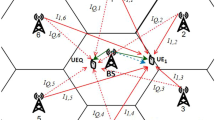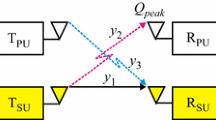Abstract
In this research outage probability is analysed for a proposed matrix based method using selection combining diversity under shadowed attenuation in a typical macrocell environment. The conventional Lognormal shadowing model approximates the gamma probability density function which is used in proposed matrix based method. The closed form expressions are developed for evaluating the probability of outage in multipath fading environment with the help of shadow matrix, shape, and scale factors. The graphical results using proposed method are validated by comparing them with the Lognormal method. The presented results have been investigated by varying threshold in terms of shadow based attenuation. The results obtained using proposed method is compared with the Lognormal model where shadowing spread is varied. It is clear from the plots that the outage probability using proposed model shows better results the outage probability as compared to Lognormal shadowed model.













Similar content being viewed by others
References
Uddin, M. F. (2016). Throughput analysis of a CSMA based WLAN with successive interference cancellation under Rayleigh fading and shadowing. Wireless Networks, 22(4), 1285–1298.
Miridakis, N. I., Vergados, D. D., & Michalas, A. (2015). Performance analysis of successive decoding based on shadowing side information under non-identical composite fading/shadowing channels. IEEE Transactions on Wireless Communications, 14(9), 4835–4846.
Nakagami, M. (1960). Them-distribution—A general formula of intensity distribution of rapid fading. In W. G. Hoffman (Ed.), Statistical methods in radio wave propagation (pp. 3–36). New York: Pergamon Press.
Miridakis, N. I., & Vergados, D. D. (2013). Performance analysis of the ordered V-BLAST approach over Nakagami-m fading channels. IEEE Wireless Communication Letters, 2(1), 18–21.
Miridakis, N. I., Matthaiou, M., & Karagiannidis, G. K. (2014). Multiuser relaying over mixed RF/FSO Links. IEEE Transactions on Wireless Communications, 62(5), 1634–1645.
Moschopoulos, P. G. (1985). The distribution of the sum of independent gamma, random variables. Annals of the Institute of Statistical Mathematics (AISM), 37(1), 541–544.
Simon, M. K., & Alouini, M. S. (2004). Digital communication over fading channels (2nd ed.). New York: Wiley.
Laourine, A., Alouini, M. S., Affes, S., & Stéphenne, A. (2009). On the performance analysis of composite multipath/shadowing channels using the G-distribution. IEEE Transactions on Communications, 57(4), 1162–1170.
Abdi, A., & Kaveh, M. (1998). K distribution: An appropriate substitute for Rayleigh–Lognormal distribution in fading-shadowing wireless channels. Electronics Letters, 34(9), 851–852.
Bithas, P. S., Sagias, N. C., Mathiopoulos, P. T., Karagiannidis, G. K., & Rontogiannis, A. A. (2006). On the performance analysis of digital communications over generalized-K fading channels. IEEE Communications Letters, 10(5), 353–355.
Romero-Jerez, J. M., & Goldsmith, A. J. (2008). Antenna array processing in fading and interference: Interference-cancellation vs. diversity comparative performance. IEEE Transactions on Wireless Communications, 7(3), 920–932.
Lin, J. C., Kao, W. C., Su, Y. T., & Lee, T. H. (1999). Outage and coverage considerations for microcellular mobile systems in a shadowed-Rician/shadowed-Nakagami environment. IEEE Transactions on Vehicular Technology, 48(1), 66–75.
Chen, J., Feng, S., Huang, M., Liu, Y., & Ke, F. (2014). Outage analysis of distributed antenna system with delayed CSI and unequal-power cochannel interferers. IEEE Communication Letters, 18(5), 769–772.
Kostic, I. M. (2005). Analytical approach to performance analysis for channel subject to shadowing and fading. IEE Proceedings on Communications, 152(6), 821–827.
Stuber, G. L. (2001). Principles of mobile communications (2nd ed.). Norwell, MA: Kluwer Academic.
Tellambura, C., & Annamalai, A. (1999). A unified numerical approach for computing the outage probability for mobile radio systems. IEEE Communication Letters, 3(4), 97–99.
Jakes, W. C. (1994). Microwave mobile communications. Washington, D.C: IEEE Computer Society Press.
Shankar, P. M. (2011). Fading and shadowing in wireless systems. New York: Springer.
Bithas, P. S. (2009). Weibull-gamma composite distribution: Alternative multipath/shadowing fading model. Electronic Letters, 45(14), 749–751.
Yilmaz, A., Yilmaz, F., Alouini, M. S., & Kucur, O. (2013). On the performance of transmit antenna selection based on shadowing side information. IEEE Transactions on Vehicular Technology, 62(1), 454–460.
Sofotasios, P. C., & Freear, S. (2010). The қ-μ/gamma composite fading model. In Proceedings of IEEE international conference on wireless information technology and systems (ICWITS), Hawaii, USA.
Sofotasios, P. C., & Freear, S. (2011). The қ-μ extreme/gamma distribution: A physical composite fading model. In IEEE proceedings of wireless communications and networking conference (WCNC), Cancun, Mexico, pp. 1398–1401.
Harput, S., Sofotasios, P. C., & Freear, S. (2011). Novel composite statistical model for ultrasound applications. In IEEE international ultrasonics symposium (IUS), Orlando, FL, USA, pp. 1387–1390.
Sofotasios, P. C. (2010). On special functions and composite statistical distributions and their applications in digital communications over fading channels, Ph.D. Dissertation, University of Leeds, UK.
Rappaport, T. S., Heath, R. W., Daniels, R. C., & Murdock, J. N. (2015). Millimetre wave wireless communications. Englewood Cliffs: Prentice-Hall.
Roh, W., et al. (2014). Millimeter-wave beamforming as an enabling technology for 5G cellular communications: Theoretical feasibility and prototype results. IEEE Communications Magazine, 52(2), 106–113.
Trigui, I., Laourine, A., Affes, S., & Stephenne, A. (2009). Outage Analysis of wireless systems over composite fading/shadowing channels with co-channel interference. In IEEE WCNC proceedings.
Karadimas, P., & Kotsopoulos, S. A. (2010). A modified loo model with partially blocked and three dimensional multipath scattering: Analysis, simulation and validation. Wireless Personal Communications, 53, 503–528.
Atapattu, S., Tellambura, C., & Jiang, H. (2010). Representation of composite fading and shadowing distributions by using mixtures of gamma distributions. In IEEE WCNC proceedings.
Ma, Y., & Chai, C. C. (2000). Unified error probability analysis for generalized selection combining in Nakagami fading channels. IEEE Journal on Selected Areas in Communications, 18(11), 2198–2210.
Shankar, P. M. (2012). A Nakagami-N-gamma model for shadowed fading channels. Wireless Personal Communications, 64, 665–680.
Ghosh, A., et al. (2014). Millimeter wave enhanced local area systems: A high data rate approach for future wireless networks. IEEE Journal of Selected Areas in Communications, 32(6), 1152–1163.
Olver, F. W. J., Lozier, D. W., Boisvert, R. F., & Clark, C. W. (2010). NIST handbook of mathematical functions. New York, NY: Cambridge University Press.
Gradshteyn, I. S., & Ryzhik, I. M. (1994). Table of integrals, series and products (7th ed.). San Diego, CA: Academic.
Author information
Authors and Affiliations
Corresponding author
Additional information
Publisher's Note
Springer Nature remains neutral with regard to jurisdictional claims in published maps and institutional affiliations.
Rights and permissions
About this article
Cite this article
Dhaka, A., Bhaskar, V., Chauhan, S. et al. Analysing Outage Probability and Diversity for Matrix Based Shadowed Attenuation in Multipath Fading Environment. Wireless Pers Commun 117, 1797–1814 (2021). https://doi.org/10.1007/s11277-020-07946-3
Accepted:
Published:
Issue Date:
DOI: https://doi.org/10.1007/s11277-020-07946-3




